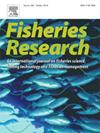How to deal with confiscated European eels (Anguilla anguilla L.) destined for reintroduction?
IF 2.2
2区 农林科学
Q2 FISHERIES
引用次数: 0
Abstract
Illegal trafficking of critically endangered European eels (Anguilla anguilla L.) to Asia for consumption is a lucrative business and considered to be Europe’s most significant illegal wildlife trade in terms of monetary value. Consequently, international and national authorities take action to intercept traffickers and confiscate glass eels. While there are potential biosecurity risks by reintroducing the eels into the wild such as pathogen spread, there are currently no guidelines on how to deal with large numbers of confiscated glass eels. In our work we provide such guidelines to put the eels in quarantine and test them for pathogens but also species identification. The latter is not only necessary to prevent the introduction of non-native species, it can also be a necessity in court. Nonetheless we stress the need for a European standard on eel quarantine and both pathogen and molecular species identification testing. In addition, due to the lack of knowledge on pathogen impacts and the effectiveness of glass eel restocking, urgent research on that front is needed to implement effective reintroduction measures.
如何处理没收的欧洲鳗鲡?
本文章由计算机程序翻译,如有差异,请以英文原文为准。
求助全文
约1分钟内获得全文
求助全文
来源期刊

Fisheries Research
农林科学-渔业
CiteScore
4.50
自引率
16.70%
发文量
294
审稿时长
15 weeks
期刊介绍:
This journal provides an international forum for the publication of papers in the areas of fisheries science, fishing technology, fisheries management and relevant socio-economics. The scope covers fisheries in salt, brackish and freshwater systems, and all aspects of associated ecology, environmental aspects of fisheries, and economics. Both theoretical and practical papers are acceptable, including laboratory and field experimental studies relevant to fisheries. Papers on the conservation of exploitable living resources are welcome. Review and Viewpoint articles are also published. As the specified areas inevitably impinge on and interrelate with each other, the approach of the journal is multidisciplinary, and authors are encouraged to emphasise the relevance of their own work to that of other disciplines. The journal is intended for fisheries scientists, biological oceanographers, gear technologists, economists, managers, administrators, policy makers and legislators.
 求助内容:
求助内容: 应助结果提醒方式:
应助结果提醒方式:


